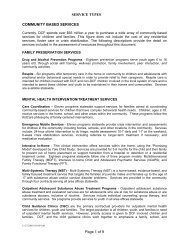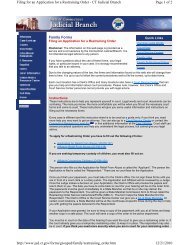Julie Cammarata - Connecticut House Democrats
Julie Cammarata - Connecticut House Democrats
Julie Cammarata - Connecticut House Democrats
You also want an ePaper? Increase the reach of your titles
YUMPU automatically turns print PDFs into web optimized ePapers that Google loves.
CONNECTICUT 30 Stott Avenue<br />
MUNICIPAL ELECTRIC Norwich, CT 06360-1526<br />
ENERGY COOPERATIVE 860-889-4088 Fax 860-889-8158<br />
January 31, 2010<br />
The Honorable Vicki Nardello, Chair<br />
Speaker’s Task Force on Electric Rates<br />
Legislative Office Building<br />
Hartford, <strong>Connecticut</strong> 06106<br />
Dear Representative Nardello:<br />
Attached are the recommendations of the <strong>Connecticut</strong> Municipal Electric Energy Cooperative<br />
(CMEEC) in response to your request for input on measures that can be implemented to reduce<br />
electric rates for customers of the Electric Distribution Companies.<br />
CMEEC appreciates the opportunity to participate on the Task Force. Although there are<br />
numerous differences between the Electric Distribution Companies (EDCs) and the municipal<br />
electric utilities that CMEEC serves, lessons can be learned from comparing processes and<br />
results of the two different regulatory structures. In fact, one of the key advantages to<br />
policymakers of having public power is that it provides a benchmarking tool for evaluating the<br />
relative impacts of various policies and processes required of the EDCs for effectiveness.<br />
However, it is critical to keep in mind that CMEEC’s historical results are the product of all of<br />
the tools it has at its disposal as well as its overall load characteristics.<br />
Once again, thank you for the opportunity to participate in this important discussion.<br />
Sincerely,<br />
<strong>Julie</strong> <strong>Cammarata</strong><br />
<strong>Julie</strong> <strong>Cammarata</strong><br />
Director, Government and Regulatory Affairs<br />
Serving Public Power in <strong>Connecticut</strong><br />
Groton Jewett City Norwich Public Norwalk Third Taxing South Norwalk Town of Wallingford<br />
Utilities Dept. of Public Utilities Utilities District Electrical Electric and Water Department of Public<br />
Department Utilities
Recommendations to the Speaker’s Task Force on Reducing Electric Rates from the <strong>Connecticut</strong><br />
Municipal Electric Energy Cooperative (CMEEC)<br />
1. Sustained informed investment in energy efficiency and load control<br />
Reductions to the amount of load requiring supply during normal hours and during peak<br />
periods have proven beneficial to <strong>Connecticut</strong> ratepayers as a whole and it is clear that continued<br />
emphasis can lead to additional economically achievable savings. Sustained informed investment<br />
in these areas will therefore save ratepayers money.<br />
The Energy Conservation Management Board (ECMB) and the <strong>Connecticut</strong> Energy<br />
Advisory Board (CEAB) both produce a wealth of information to assist the Electric Distribution<br />
Companies (EDCs), regulators and policy-makers in evaluating appropriate levels of investment<br />
in these areas. For example, CEAB’s Integrated Resource Plan (IRP) includes scenario analyses<br />
of varying types and levels of conservation and load control measures for cost effectiveness that<br />
can be used to guide investment decisions.<br />
2. Consider exploring flexible procurement strategies<br />
As was noted time and again by members of the Task Force panel, generation costs are<br />
the largest single component of retail electric rates. This component is driven by the underlying<br />
wholesale cost of electricity, regardless of the procurement strategy used. Wholesale cost drivers<br />
vary but most are outside the direct control of state regulatory authorities and purchasers in the<br />
market. However, the ability to seize opportunities to purchase at lows in the market can make a<br />
difference in the ultimate price consumers pay.<br />
Currently, the EDC’s Standard Offer procurement process is prescriptive by law,<br />
specifying to varying degrees when, how, what kind, and how much supply is bought. CMEEC’s<br />
procurement strategy is more flexible, allowing it certain discretion to seize market opportunities<br />
when they occur. This greater flexibility has proven advantageous for CMEEC and may be<br />
worth exploring to some degree in future Standard Offer procurements as a means to reduce<br />
rates.<br />
We caution that a tool such as procurement flexibility it is not a panacea in a volatile<br />
power market environment such as exists in New England. Not all transactions will ultimately<br />
reduce system cost if the market moves in unexpected directions. There are many differences<br />
between CMEEC and the EDCs that can also contribute to legitimate differences in their power<br />
supply procurement strategies. The most significant of these differences are associated with size.<br />
When CMEEC enters into a 25 MW transaction, there is little or no movement in market prices.<br />
When one of the EDCs executes a 300 MW – 500 MW transaction, it can have a significant<br />
impact on market prices. The results of a successful power supply procurement strategy are the<br />
product of all of the portfolio management tools a utility has at its disposal, including fuel and<br />
other hedging tools.
3. Continued informed investment in the grid’s infrastructure<br />
Rates have been and will continue to be impacted by the physical condition of the electric<br />
grid. For example, transmission constraints in southwest <strong>Connecticut</strong> had the effect of impeding<br />
the flow of cheaper power to load centers and keeping ratepayers reliant on older, less efficient<br />
and more expensive power. This resulted in ratepayers getting charges for congestion and uplift<br />
costs through the wholesale market. Transmission investments made for reliability in southwest<br />
<strong>Connecticut</strong> have had positive impacts toward reducing rates in the State by relieving these<br />
congestion-related charges. Continued active participation in ISO New England-administered<br />
regional planning and state-administered analyses can help to identify needed upgrades to the<br />
grid before the price impacts of physical deficiencies reach consumers.












